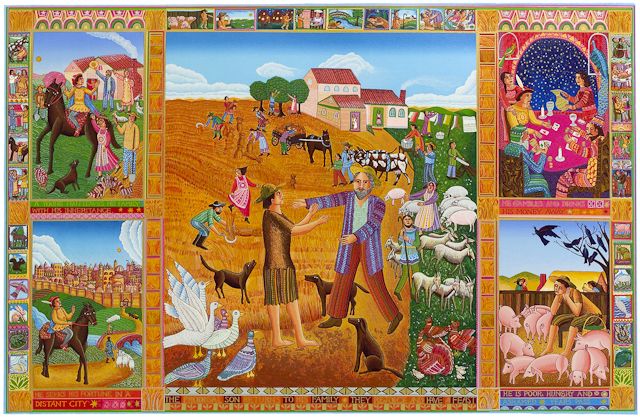
Prodigal Son
23″ x 35.5″ | 69 colors | AP 1/18 | 1984
The interpretation of this well-known biblical story captures, in narrative form, the progression of the son’s journey from the anticipation of adventure, to the temptation and struggles of life, and finally to the joys of homecoming. In the story we see God’s unrestricted love, compassion, and forgiveness of rebellious humanity.
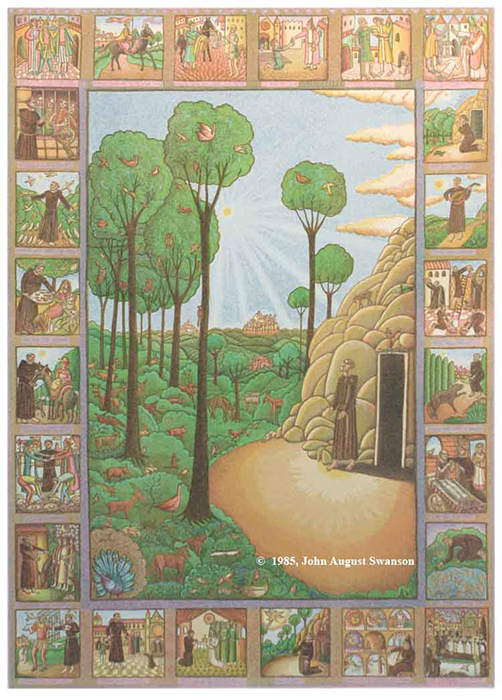
Francis of Assisi
Lithograph | 27″ x 19.5″ | 6 colors | AP | 1985
St. Francis of Assisi is surrounded by a host of birds and animals within a stylized landscape. Francis does not dominate the scene but rather abides in harmony with creation. Swanson’s color palette is gentle and inviting. A narrative of vignettes from the life of St. Francis trigger memories of this well-known and loved saint who called his fellow creatures brother and sister.

Epiphany
Serigraph | 38″ x 12″ | 48 colors | 170/210 | 1988
This print presents a beautiful visual narrative of the Adoration of the Magi as told in Matthew 2:1-12. Three wise men, dressed in lavish garments and riding camels, follow the star of Bethlehem to pay homage to the newborn king of the Jews. Their long journey takes them on a winding road above which a group of angels surrounds the guiding star in a night sky.

Nativity
Serigraph | 38″ x 12″ | 42 colors | 70/210 | 1988
The humility of Christ’s birth stands out with Mary and Joseph in a simple stable. The rolling hills create a backdrop of rich colors and textures with Jerusalem in the distance. Neighbors, with children in hand, bring simple gifts. A multitude of angels dance and sing in a star-rich sky, and flowers surround the birthplace signifying the beauty and sweetness of God’s Incarnation.

Shepherds
Serigraph | 38.5″ x 12″ | 46 colors | 170/175 | 1985
Here the angels announce the birth of Christ to shepherds who keep watch over their sheep. Jesus tells us that he is the Good Shepherd, and we are his sheep over whom he keeps watch. Lush, green hills provide rich pasture for the sheep who are secure with their shepherds. As with the other two images in the triptych, the starry sky is alight with the joy of the angels.
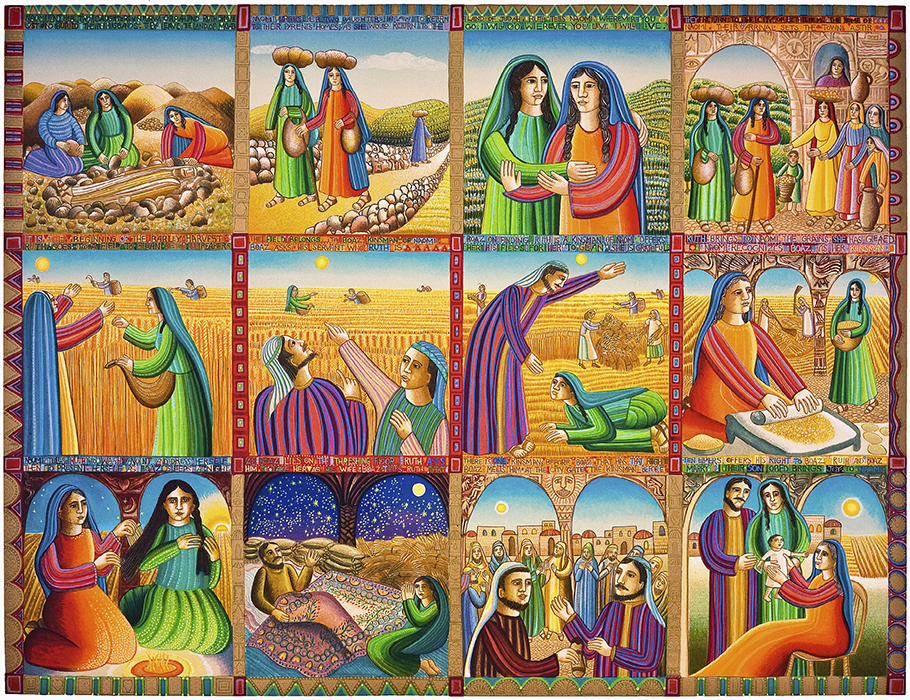
Story of Ruth
Serigraph | 21.25″ x 27.75″ | 250 colors | 23/280 | 1991
This piece includes twelve tiles telling the Old Testament story of Ruth in narrative form. The meaning of the name Ruth is “grace.” Being a Moabite, she receives unmerited blessings from God despite her status as a gentile woman. Swanson describes it as “a testimony to move forward boldly in faith, to take our part in the larger picture of God’s plans” (Artist’s Notes).
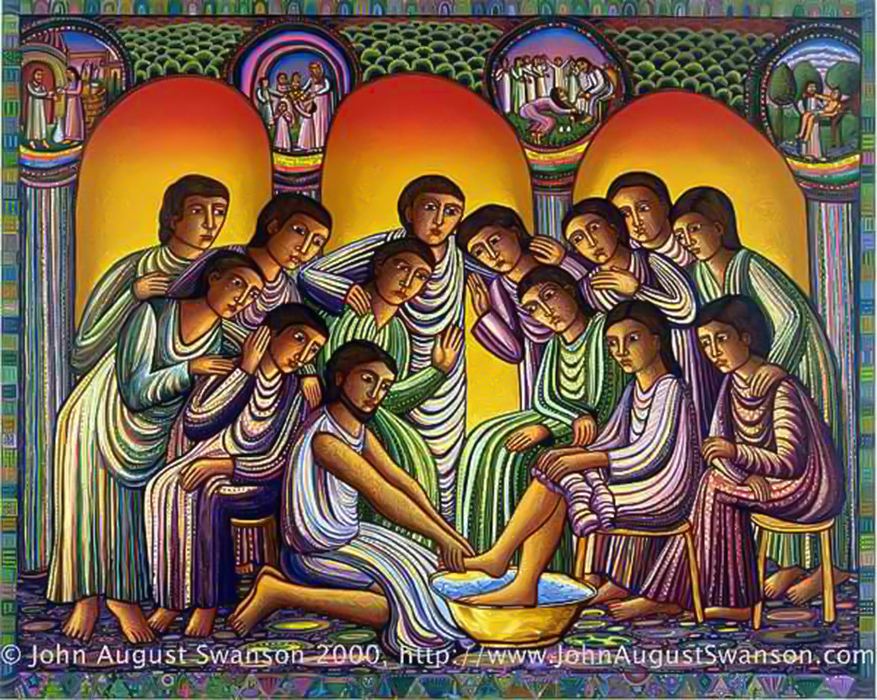
Washing of the Feet
Serigraph | 21″ x 26″ | 33 colors | 185/200 | 2000
“This Paschal season ritual provides a beautiful guide for life, calling us to treat all with respect and humility” (Swanson, Artist’s Notes). Captivated apostles gather around Jesus as he washes the feet of his own. At the center on the floor is a golden water bowl emphasizing the beauty and transcendence of acting in service to others.
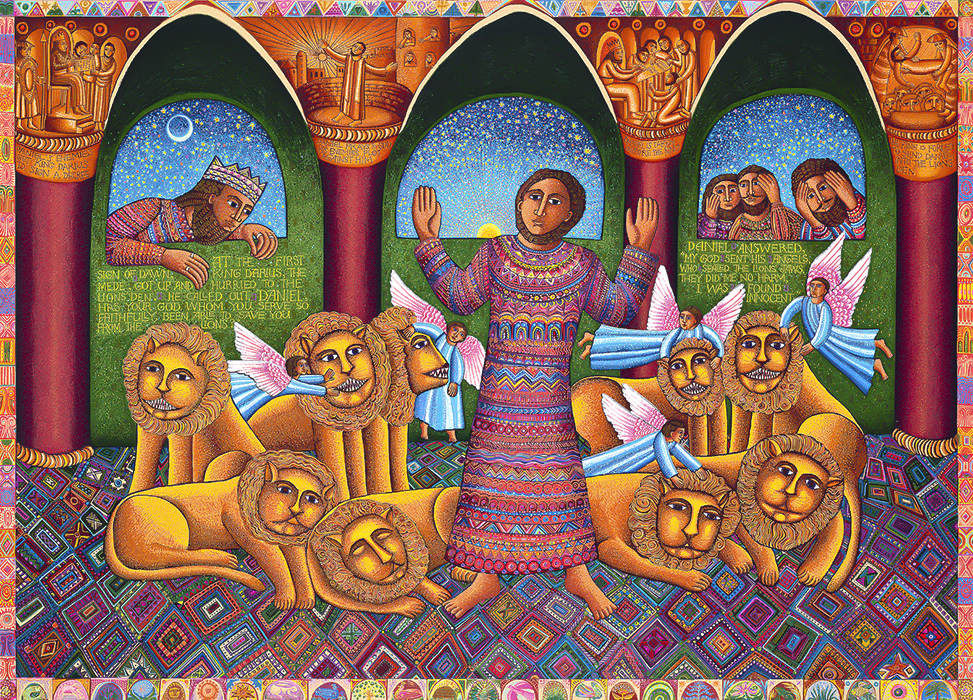
Daniel
Serigraph | 21″ x 29.5″ | 35 colors | 124/220 | 2000
Rich garments and patterns suggest the Babylonian exile from which the Jews sought release. Sentenced to a terrifying death because of his faith, Daniel stands unharmed in the lions’ den while angels calm the ferocious beasts. The king looks on in shock, expecting Daniel to be torn apart instantly. The sun rises in the background, symbolizing the triumph of good over evil.
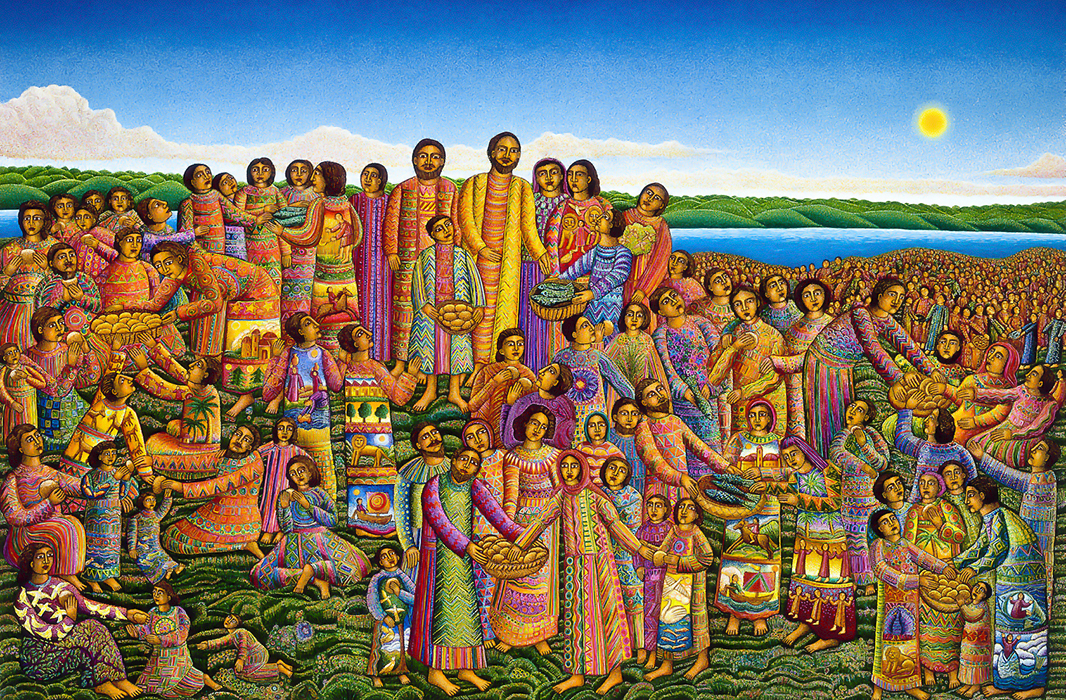
Loaves and Fishes
Serigraph | 24″ x 36″ | 54 colors | 70/250 | 2006
Depicted is a large crowd of 5000 men, not counting women and children, clamoring around Jesus. He gives thanks over five loaves and two fish and has his disciples distribute them. The food multiplies, and all are satisfied. In the scene, all are clothed in richly colored and patterned garments. In the middle stands Jesus, the only one who can truly satisfy the hunger of humanity.
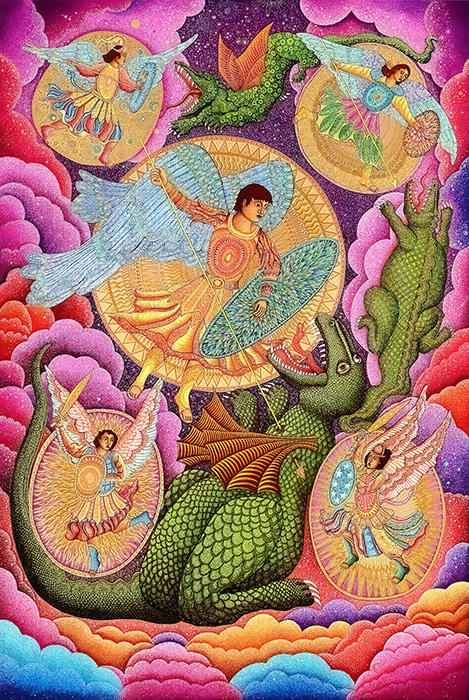
Michael and the Archangels
Serigraph | 62 colors | 30″ x 20” | AP 2/18 | 2006
Michael, an ancient name meaning “who is like God,” and the other archangels are depicted in the cosmic struggle between good and evil. Michael, in battle attire and symbol of the divine, casts out demonic forces by spearing the dragon. Around Michael are four openings into the divine with angels holding swords surrounded by volatile red, rose, and blue turbulence.
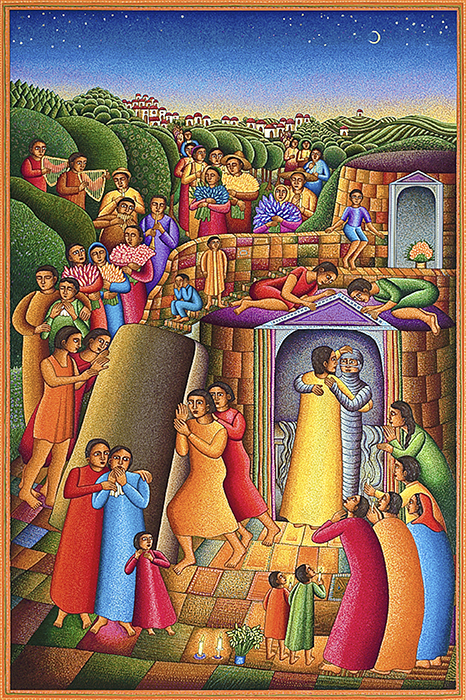
Take Away the Stone
Serigraph | 57 colors | 30″ x 20″ | 52/250 | 2006
Here, Lazarus is raised, as described in St. John’s Gospel. Swanson says of the scene: “We are constantly being called to come out of the tomb. We, like Lazarus, are often overwhelmed by the many ways death is present in the midst of our lives” (Artist’s Notes). One can see the wrapping and constricting bonds that covered Lazarus and ask: what are the constricting bonds in my life?
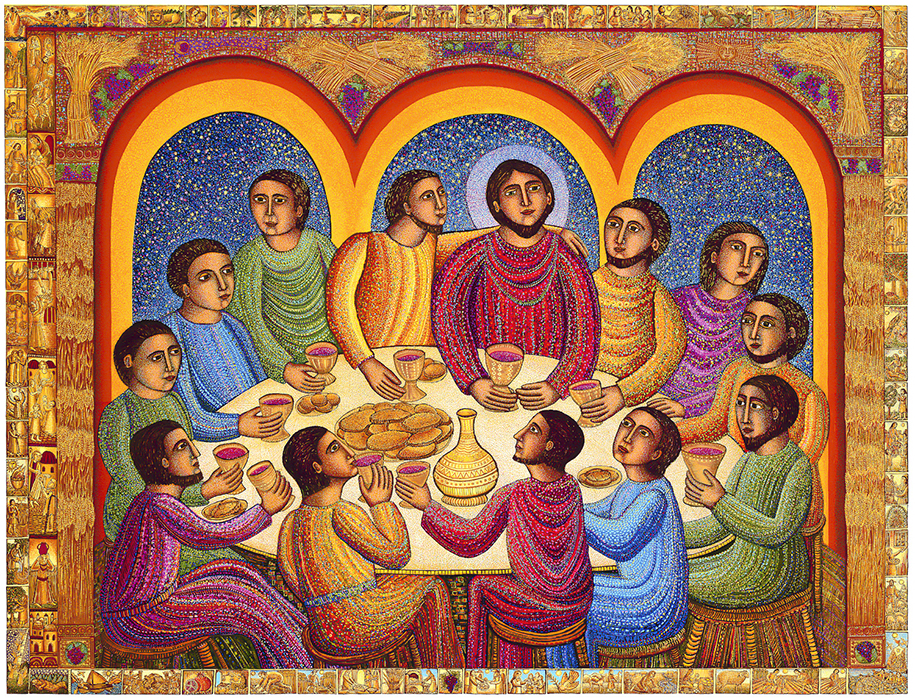
Last Supper
Serigraph | 21″ x 26″ | 33 colors | 38/200 | 2009
Jesus is depicted at the circular table as both host and companion. Here “[w]e are all participating in this supper” (Swanson, Artist’s Notes). The scene of the apostles gathered round is one of intimacy as St. John rests his arm on Jesus’ shoulders. Through the three arches behind, we view an eternal starry sky suggesting the presence of the Divine.
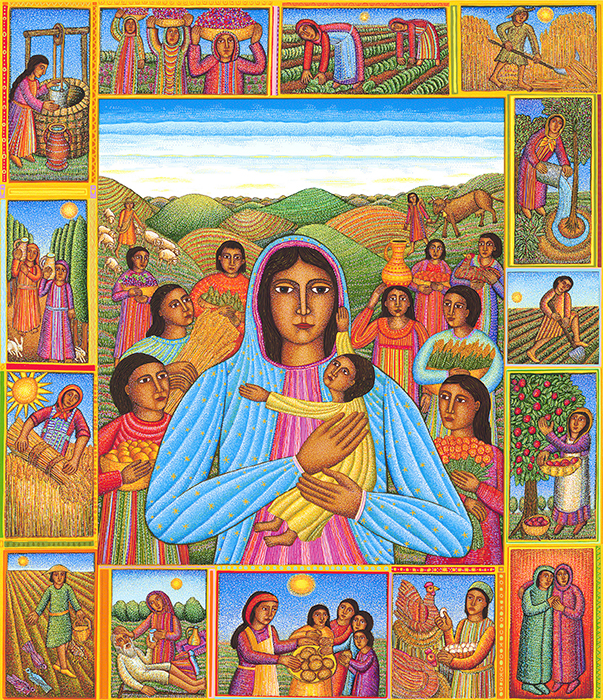
Madonna of the Harvest
Serigraph | 18.5″ x 15.5″ | 42 colors | 9/180 | 2009
Mary is portrayed as a young mother whose beauty and fruitfulness are echoed in creation. Mary is shown with garments of blue, red, and gold in patterns reminiscent of the furrows of the fields. Surrounding the Madonna are images of people bringing the fruits of the harvest to her, while the narrative depicts harvesting scenes reminiscent of the fruits of grace in our own lives.
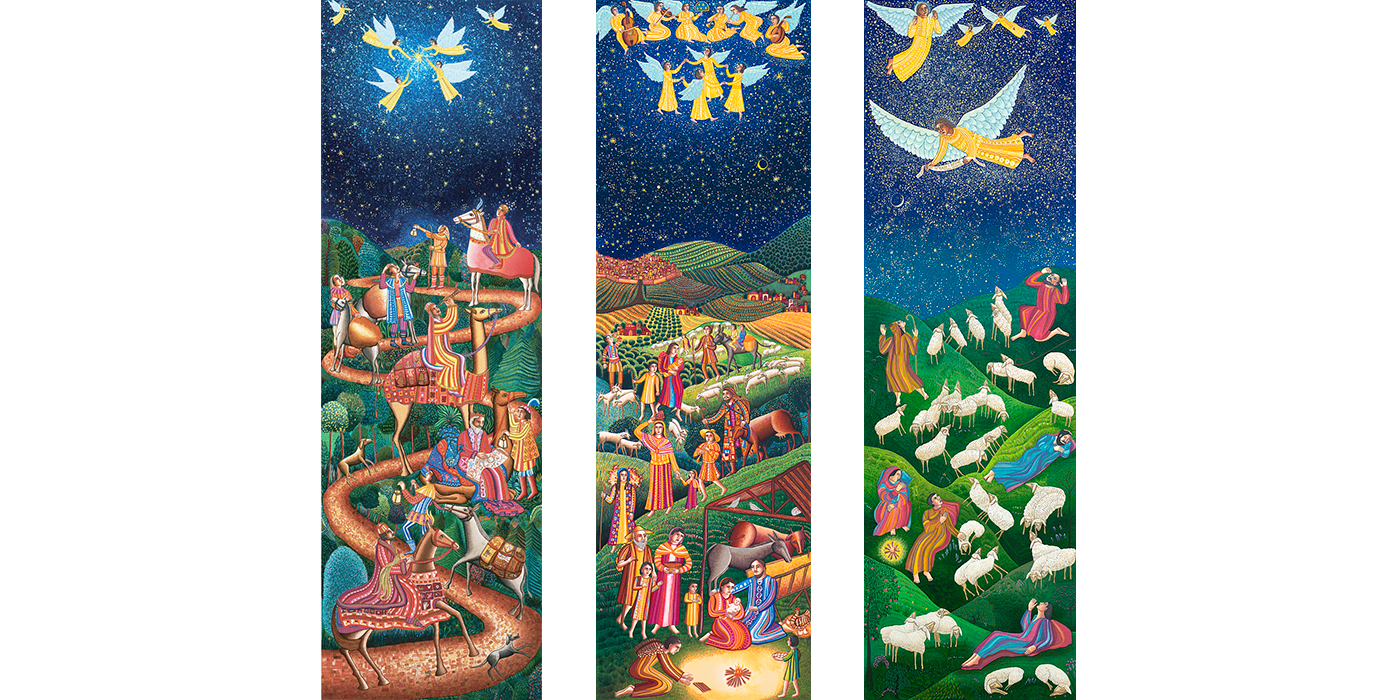

 John August Swanson was born on January 11, 1938, in El Monte, California, and died on September 23, 2021, in Los Angeles. He worked in oil, watercolor, acrylic, and mixed media, and was a printmaker of limited edition serigraphs, lithographs, and other fine prints. He was a socially conscious Catholic with deeply incarnational vision who embraced the possibility of spiritual transformation.
John August Swanson was born on January 11, 1938, in El Monte, California, and died on September 23, 2021, in Los Angeles. He worked in oil, watercolor, acrylic, and mixed media, and was a printmaker of limited edition serigraphs, lithographs, and other fine prints. He was a socially conscious Catholic with deeply incarnational vision who embraced the possibility of spiritual transformation.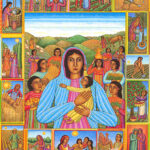 In most of his serigraphs, he includes vignettes around the edge (e.g., scenes drawn from a scriptural text or the life of a saint) to provide context for his central theme. Narrative art allows for events of different times to be read as part of a larger story over time. In this way, Swanson’s art is a story to be seen and read.
In most of his serigraphs, he includes vignettes around the edge (e.g., scenes drawn from a scriptural text or the life of a saint) to provide context for his central theme. Narrative art allows for events of different times to be read as part of a larger story over time. In this way, Swanson’s art is a story to be seen and read.












